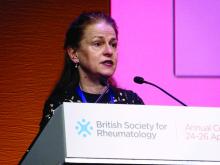LIVERPOOL, ENGLAND — An updated guideline from the British Society for Rheumatology (BSR) on the management of Sjögren disease asks rheumatologists and other clinicians caring for patients with the condition to “do the little things well” rather than overly focusing on rheumatologic treatments. The guideline’s new format provides recommendations for specific clinical questions and now also includes recommendations for managing the disease in children and adolescents.
“The original guideline was published in 2017, and things move on very rapidly,” consultant rheumatologist Elizabeth Price, MBBCh, PhD, said ahead of her presentation of the updated guideline at the annual meeting of the British Society for Rheumatology.
“We approached the update in a slightly different way,” said Dr. Price, who works at Great Western Hospital NHS Foundation Trust in Swindon, England. She was the chair of the new guideline’s working group and convenes the BSR’s Special Interest Group for Sjögren disease.
Previously, the approach was to look at the management of Sjögren disease affecting the eyes, mouth, salivary glands, and, in turn, systemic disease. “This time we posed questions that we felt needed to be asked, interrogated the literature, and then used that to come up with our recommendations,” Dr. Price said.
The answers to those questions were used to form the 19 recommendations that now make up the guideline. These cover four key areas on the management of Sjögren disease: confirming the diagnosis, treating the symptoms, managing systemic disease, and considering special situations such as planned pregnancy and comorbidities. There is also lifestyle advice and information about where to get good patient education.
What’s in a Name?
The BSR guideline on the management of adult and juvenile onset Sjögren disease is published in Rheumatology and is available via the BSR website, where it is accompanied by a short summary sheet.
The most notable change perhaps is the name the guideline now uses, Dr. Price said at BSR 2024. “We have been bold and called it Sjögren disease.” Previously, the guideline used the term primary Sjögren’s syndrome, but there has been a “move away from using eponymous syndromes and dropping s’s and apostrophes,” she explained.
Another significant change is that advice on managing Sjögren disease in children and adolescents is now included where appropriate, meaning that the British guideline is now the first to cover Sjögren disease “across the ages,” Dr. Price said.
A pediatric/adolescent rheumatologist joined the guideline working group, which already consisted of several adult rheumatologists, ophthalmologists, and a dentistry consultant. The group now comprises 22 members total, including a general practitioner, an oncologist, a renal physician, an occupational therapist, two patients with Sjögren disease, and a librarian.
Confirming the Diagnosis
The first questions asked to help form the new recommendations were around confirming a diagnosis of Sjögren disease, such as what is the diagnostic accuracy of antinuclear antibodies (ANAs), extractable nuclear antigens (ENAs), and other novel antigens in Sjögren disease? And what is the diagnostic accuracy of salivary gland ultrasound, imaging in general, and salivary gland or lacrimal gland biopsies?
The resulting recommendations advised not to measure ANAs in the absence of clinical indicators of Sjögren disease or any other connective tissue disease but to use it to screen if there was a clinical suspicion. And ENAs should be measured even if the ANAs were negative and there is a high index of suspicion.
In terms of imaging, ultrasound of the salivary glands was thought to be useful, but other imaging was not recommended for routine practice at the current time. Minor lip but not lacrimal gland biopsies were recommended if clinical and serologic features were not enough to make a diagnosis.


